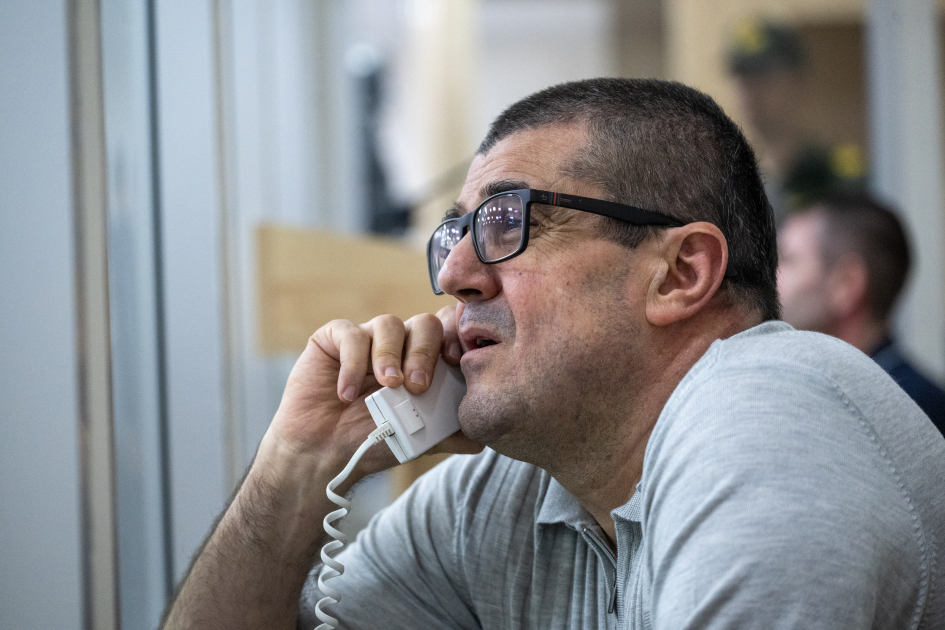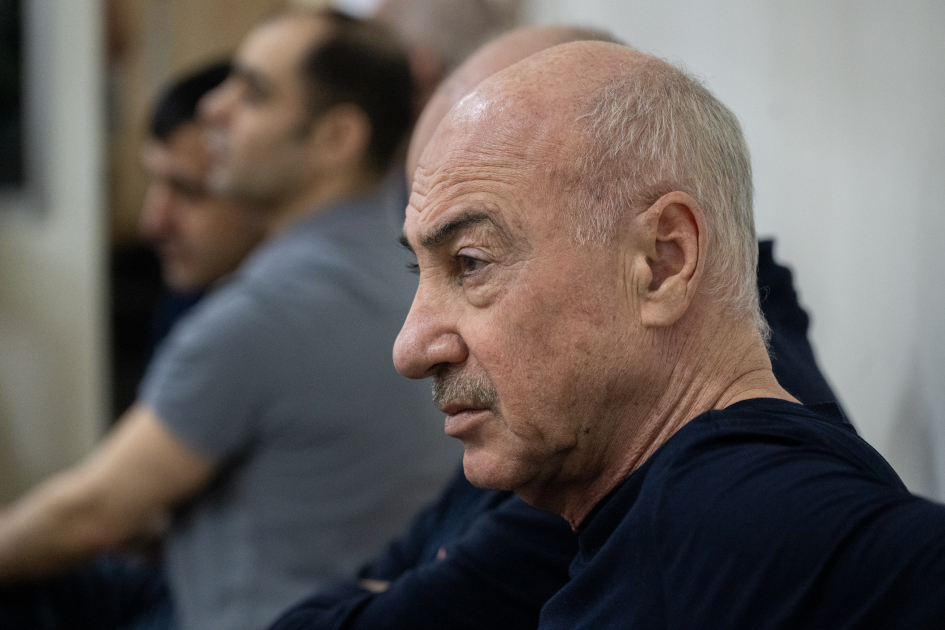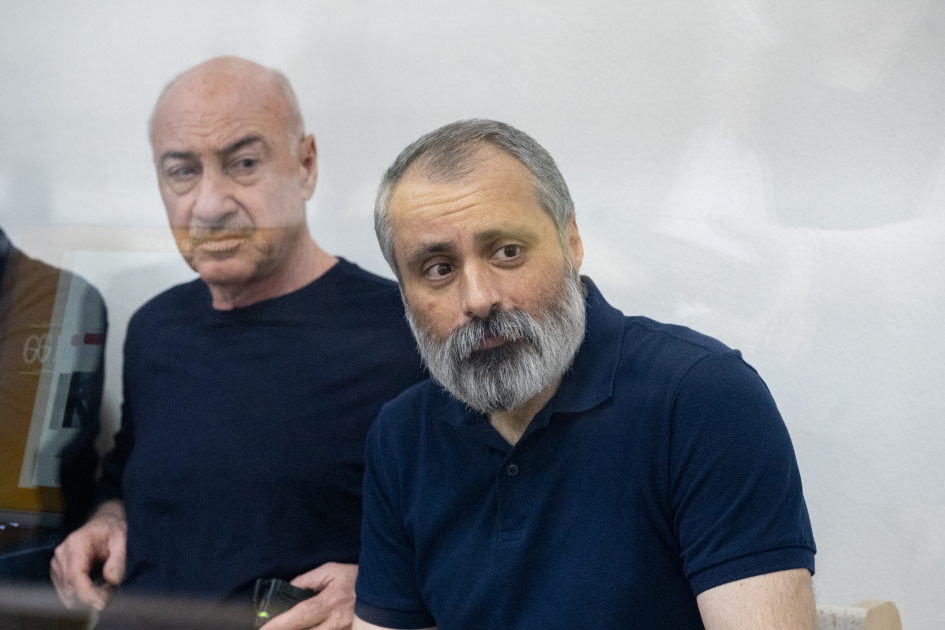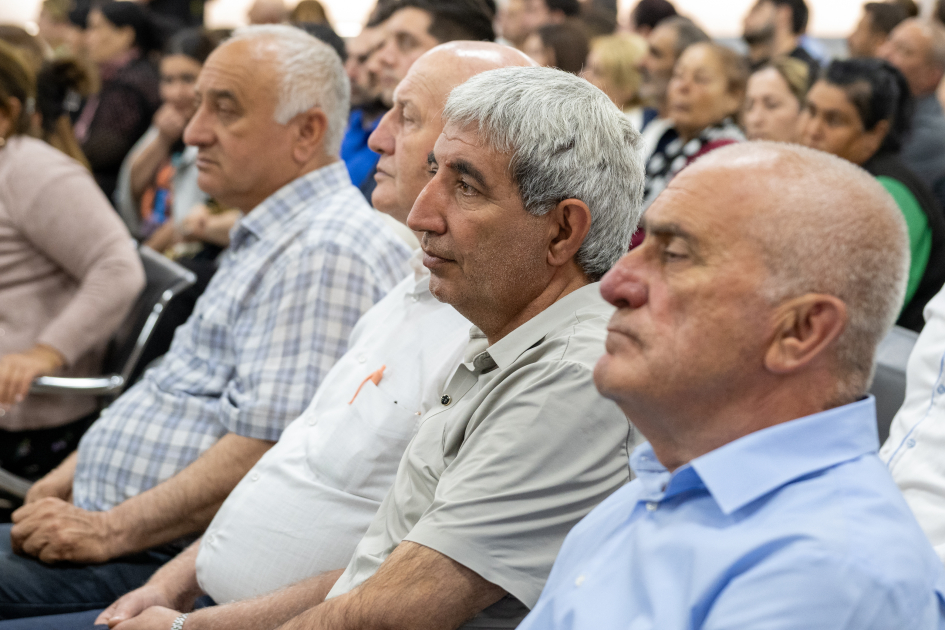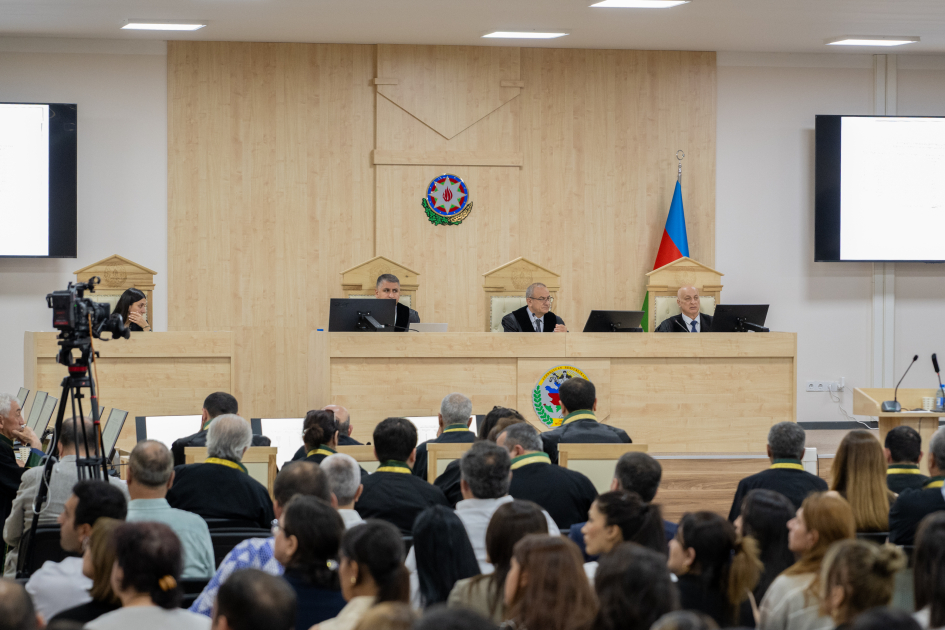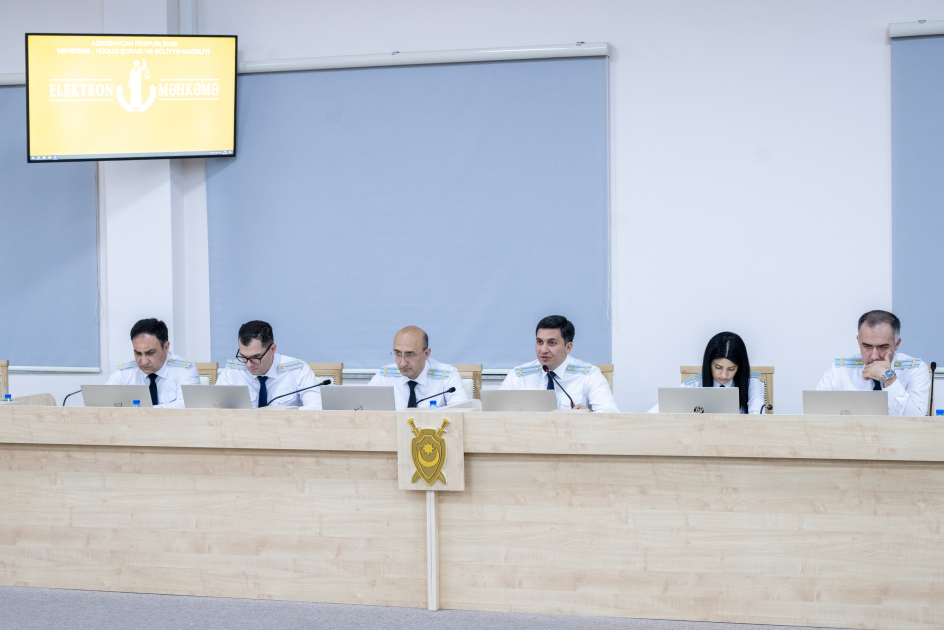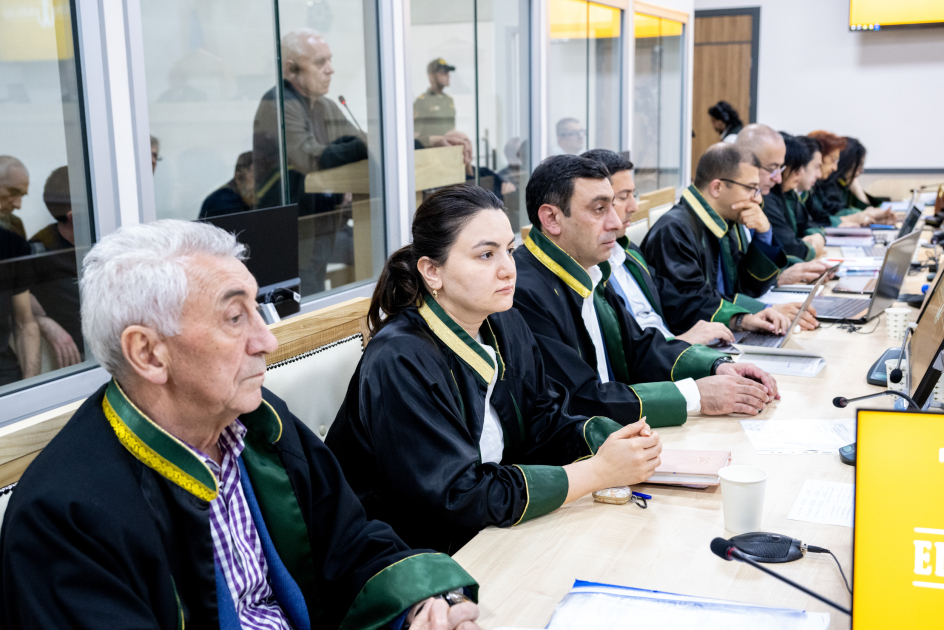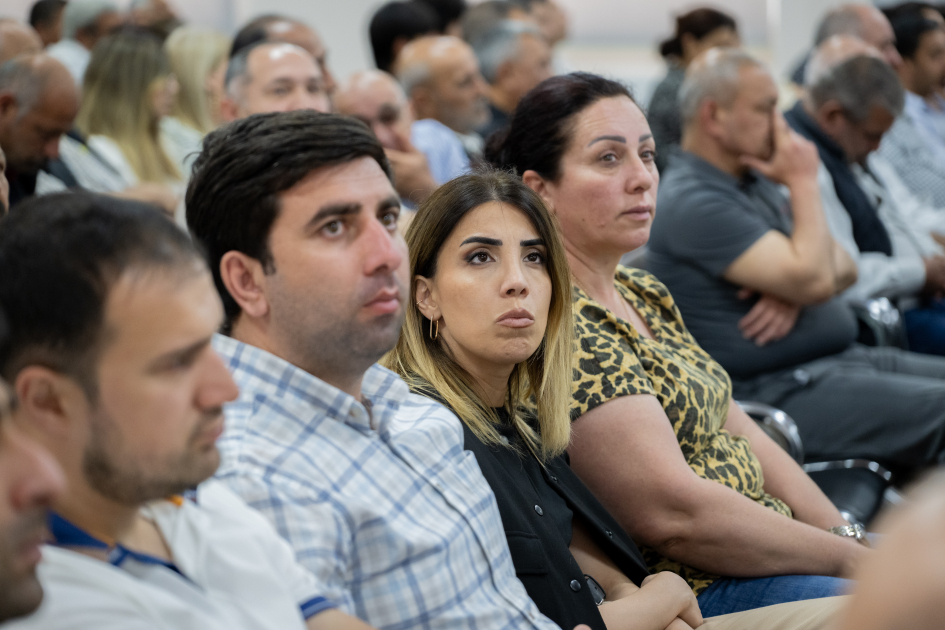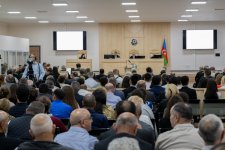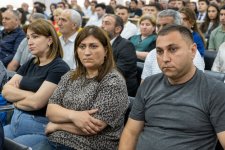BAKU, Azerbaijan, June 5. The open court session in the criminal case against Arayik Harutyunyan, Arkadi Ghukasyan, Bako Sahakyan, Davit Ishkhanyan, David Babayan, Levon Mnatsakanyan, and others, citizens of the Republic of Armenia, who are accused of committing crimes against peace and humanity, war crimes, including the preparation and conduct of aggressive warfare, genocide, violation of the laws and customs of war, as well as terrorism, financing of terrorism, forcible seizure of power, forcible retention of power, and numerous other crimes as a result of Armenia's military aggression against Azerbaijan, continued on June 5, Trend reports.
At the court session held in the Baku Military Court under the chairmanship of Judge Zeynal Agayev, consisting of Jamal Ramazanov and Anar Rzayev (reserve judge Gunel Samadova), each of the defendants was provided with a translator in their native language, as well as lawyers for their defense.
The defendants, their defenders, some of the victims, their legal successors and representatives, as well as the prosecutors representing the state prosecution, participated in the hearing.
During the court proceedings, it was first announced that a new lawyer had joined the defense for the defendant Davit Ishkhanyan. D. Ishkhanyan stated that he did not object to the new lawyer. He recalled that he had requested to review the minutes of the court session held on May 26 in one of the previous proceedings, and he stated that he also wanted to review the minutes of the court proceedings held on May 24, in addition to that date.
Judge Zeynal Agayev informed the defendant that conditions would be created in the coming days to review the minutes of the court session, at which time he could review the minutes he requested.
At the trial, documents were examined regarding the facts of intentional damage to the ecology and economy of the Republic of Azerbaijan in the course of the aggressive war carried out by the Republic of Armenia.
It was stated that after the liberation of the occupied territories of the Republic of Azerbaijan, inspections were carried out in those territories, and during the inspection, the damage caused to each district and village was determined.
With the participation of Tugay Rahimli, assistant to the Prosecutor General for special assignments, the documents examined listed the damage caused to nature and the economy in the Zangilan, Jabrayil, Fuzuli, Gubadli, Aghdam, Khojavend, Shusha, Tartar, Lachin, Kalbajar districts and villages of those districts. These damages include both the destruction of trees and the illegal exploitation of mineral deposits.
The displayed photos proved that the trees were deliberately destroyed, not naturally.
At the trial, space images of the illegal exploitation of mineral deposits, including raw material and ore deposits, in the formerly occupied districts were also shown.
It was stated that during the years 1992–2023, under the leadership and participation of the defendants - Harutyunyan Arayik Vladimiri, Ghukasyan Arkadi Arshaviri, Sahakyan Bako Sahaki, Ishkhanyan Davit Rubeni, Manukyan David Azatini, Babayan David Klimi, Mnatsakanyan Levon Henrikovich, and others, underground and surface natural resources belonging to the Azerbaijani people and state were plundered in the occupied territories.
According to the documents examined with the participation of state prosecutor Fuad Musayev, the income or other material assets obtained as a result of the looting were directed to financing the Armenian army, armed groups formed by the criminal organization, mercenaries brought from foreign countries, providing them with various types of weapons, clothing, food and other necessary needs, and increasing the combat capability of the armed formations included in the criminal organizations. Thus, increasing financial resources for the further strengthening of criminal activity and preparing criminal plans in connection with the political and military leadership of the Republic of Armenia were ensured.
Later, existing information on the exploitation of the mentioned ores, raw materials and other natural resources through companies and enterprises organized and managed by members of the criminal organization was presented.
It was emphasized that the relevant natural and raw material-ore resources in the aforementioned territories were exploited under the direct leadership and control of the leading members of the criminal organization in question.
At the trial, documents related to the illegal construction and operation of hydroelectric power plants (HPPs) in the territories of Azerbaijan during the occupation period were also examined.
Later, video footage shot by the Armenians of the "military parade" held in May 2012 in Khankendi, a city in Azerbaijan's formerly occupied territories, was shown at the trial. Levon Mnatsakanyan was invited to the stand, and Nasir Bayramov, head of the department of the State Prosecution Protection Department of the Prosecutor General's Office, asked him questions.
Levon Mnatsakanyan, who held high positions in the Armenian armed forces, including deputy chief of the general staff, as well as "defense minister" in the so-called regime, first answered questions about the "parade" during the interrogation. He said: "When we held the "parades", we relied on the experience of the former USSR. Usually, a basic annual preparation plan was drawn up for the holding of the "parades". Also, anniversaries - 5, 10, 15, 20, 25 years - were the basis for holding these "parades". If you ask about my connection with the "parades", I was the chief of staff of the "defense army" in 2012. I was the person responsible for the preparation of that "parade". During the "parade", I presented the personnel to the "army commander", who, in turn, reported to the "head of the country".
Besides that, I also participated in two or three parades in the Republic of Armenia."
He stated that the "parade" was dedicated to the 20th anniversary of the so-called regime's "army" and said in response to the prosecutor's question that they used the expression "Yeraton" - three holidays at that time, and this "parade" was also organized on the occasion of "Yeraton". These holidays include May 8 – the occupation of Shusha, May 9 - Victory Day in the Second World War, and the day of the creation of the regime's "army".
In the continuation of the video footage, it is stated that the commander of the "parade" was the "first deputy commander of the army, chief of staff" of the so-called regime, Major General Levon Mnatsakanyan. The "parade" is received by Movsis Hakobyan, the "Minister of Defense" of the so-called regime.
The defendant also listed the names of other participants in the "parade": "I will say from right to left: "Chairman of the Parliament" Ashot Ghulian, clergyman Servazan, Seyran Ohanyan, who was the Minister of Defense of the Republic of Armenia at that time, "President" Bako Sahakyan, former President of the Republic of Armenia Serzh Sargsyan (who was the President of Armenia at that time - ed.), the head of the Armenian Church - Catholicos, as well as the 2nd President of Armenia Robert Kocharyan, Arkadi Ghukasyan, and Arayik Harutyunyan, who was the "Prime Minister" at that time."
Levon Mnatsakanyan said that there were all types of artillery weapons at the "parade" and added: "D-30, D-20, anti-tank weapons, BM-21 Grad, self-propelled artillery systems... There were missile complexes, if I'm not mistaken, "Smerch", "Tochka". Tanks, infantry fighting vehicles were among the armored vehicles."
He also said that some of the weapons used in the "parade" were brought from Armenia and stated: "There are weapons in this "parade" that are not in the arsenal of the "defense army." But it was brought for the military "parade". I think that if "BM 80", "Tochka", "Smerch" were in that "parade", they were brought from Armenia."
Levon Mnatsakanyan stated that the regime's "army" is considered part of the Armenian armed forces, and that the appointment to the position of "commander" was carried out by the President of Armenia based on the presentation of the Armenian Minister of Defense, and said: "Later, this appointment was made by the Prime Minister of Armenia."
The defendant said that a list of weapons needed by the regime's "army" was compiled, on the basis of which they received weapons from Armenia, and no payment was made in return.
Levon Mnatsakanyan also answered questions about the shelling of Aghdam, Tartar, Fuzuli, Aghjabadi and other territories with large-caliber weapons and other weapons during the events conditionally called the "April Battles" in 2016 – from April 2 to the end. The defendant claimed that they were the defending party, not the attacking party, at that time.
The defendant said that during the events, he was reported to by the division commanders: "They reported to me and asked that appropriate decisions be made. Those decisions were approved by me."
He stated that he reported on the events to Artak Davtyan, the head of the operations department of the Armenian armed forces, and Yuri Khachaturov, the chief of general staff. "After I reported, the chief of general staff ordered that even the reserves be withdrawn to the concentration areas."
The defendant also listed the tasks he received from the Armenian armed forces during the April battles. These tasks included strengthening the front line, withdrawing reserves to the relevant districts, carrying out additional staffing, and using all means to prevent the enemy's attack.
Levon Mnatsakanyan stated that they used "D-20", "D-30" weapons, Grad rockets, and firearms during the April battles.
He claimed that they did not target civilians at that time.
The court process will continue on June 12.
he said persons, i.e. Arayik Vladimiri Harutyunyan, Arkadi Arshaviri Ghukasyan, Bako Sahaki Sahakyan, Davit Rubeni Ishkhanyan, David Azatini Manukyan, Davit Klimi Babayan, Levon Henrikovich Mnatsakanyan, Vasili Ivani Beglaryan, Erik Roberti Ghazaryan, Davit Nelsoni Allahverdiyan, Gurgen Homeri Stepanyan, Levon Romiki Balayan, Madat Arakelovich Babayan, Garik Grigori Martirosyan, Melikset Vladimiri Pashayan, are being charged under Articles 100 (planning, preparing, initiating and waging a war of aggression), 102 (attacking persons or organizations enjoying international protection), 103 (genocide), 105 (extermination of the population), 106 (enslaving), 107 (deportation or forced displacement of the population), 109 (persecution), 110 (enforced disappearance of people), 112 (deprivation of liberty contrary to international law), 113 (torture), 114 (mercenary service), 115 (violation of the laws and customs of warfare), 116 (violation of international humanitarian law during armed conflict), 118 (military robbery), 120 (intentional murder), 192 (illegal entrepreneurship), 214 (terrorism), 214-1 (financing terrorism), 218 (creation of a criminal association (organization)), 228 (illegal acquisition, transfer, sale, storage, transportation and possession of weapons, their components, ammunition, explosives and devices), 270-1 (acts threatening aviation security), 277 (assassination of a state official or public figure), 278 (forcible seizure and retention of power, forcible change of the constitutional structure of the state), 279 (creation of armed formations and groups not provided for by law) and other articles of the Criminal Code of the Republic of Azerbaijan.








